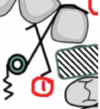Orthodontics- upper removable appliances Flashcards
How does an upper removable appliance work?
It applies pressure to move the teeth through tipping and tilting movements.
Discuss the advantages and disadvantages of an upper removable appliance.
Adv-
Excellent anchorage
easier to maintain oral hygiene
Non-destructive to tooth surfaces.
Disadv-
Patient can remove it
Can only move 2 teeth at once
Rotations are difficult to correct.
Less precise control of movement.
What are the components of stainless steel?
72% Iron
18% Chronium
8% nickel
- 7% Titanium
- 3 % carbon
What does ARAB stand for ?
Active component
Retentive components.
Achorage
Baseplate/
What is the active component?
The part that is moving the teeth through the application of force.
what type of stainless steel wire is used in orthodontic appliances?
Hard circular stainless steel wire.
Name this active component.
Give :
its function.
Its location
the characteristics of the wire.

Finger Spring and guard.
Moves teeth backwards.
Palatally.
0.5mm HSSW.
Name this active component
Give :
its function.
Its location
the characteristics of the wire.

Z spring.
Pushes teeth straight forward
Palatally.
0.5mm HSSW
Name this active component
Give its position
Characteristics of the wire.

Flapper spring.
Palatally
0.5 HSSW
Name this active component
Give :
Its position
The characteristics of the wire.

T spring.
Buccal movement of the teeth.
Palatally.
0.5mm HSSW
Name this active component.
Give :
its function.
Its location
the characteristics of the wire.

Buccal canine retractor
Retract teeth backwards and inwards.
Buccal.
0.5mm HSSW and 0.5mm internal diameterTubing
Name this active component
Give :
its function.
Its location
the characteristics of the wire.

Robert’s retractor
It moves teeth backwards and provides retention.
Buccal
0.5mm HSSW with 0.5mm of internal tubing.
Why do we use tubing?
To give strengtht to the buccally placed active components as the wire is commonly distorted on the buccal side.
Name the 5 intra-oral displacement forces.
Tongue
Gravity
Chewing through mastication
Talking
Active component.
Name this retentive factor.
What is its function.
Discuss the wire characteristic.

Adam’s clasp
Provides posterior retention. (goes into the undercut of the 6s)
0.7mm HSSW.
Name this retentive factor.
What is its function.
Discuss the wire characteristic.

This is the southend clasp.
Provides anterior retention
0.7mm HSSW
Name this retentive factor.

This is the labial bow.
Which posterior teeth do we choose to clasp and why?
6s and the 4s.
6s- they have the biggest roots .
4s-to prevent wire overlapping (which would happen if we chose the 5s and the 6s)







